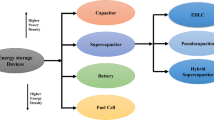Abstract
The electromotive forces (emf) E A and E C of the following concentration cells with transference: \({\text{Ag}}\left| {{\text{AgCl}}} \right|{\text{KCl (}}m_2 {\text{)}}\left\| {{\text{KCl(}}m_1 {\text{)}}\left| {{\text{AgCl}}} \right|{\text{Ag and K}}_{\text{x}} {\text{Hg}}_{{\text{1}} - {\text{x}}} |{\text{KCl(}}m_1 {\text{)}}} \right\|{\text{KCl(}}m_2 {\text{)|K}}_{\text{x}} {\text{Hg}}_{{\text{1}} - {\text{x}}} ,\) respectively, together with the emfs E MAX of the corresponding double cell without transference: \({\text{K}}_{\text{x}} {\text{Hg}}_{{\text{1}} - {\text{x}}} \left| {{\text{KCl(}}m_1 {\text{)}}} \right|{\text{AgCl}}\left| {{\text{Ag}} - {\text{Ag}}} \right|{\text{AgCl}}\left| {{\text{KCl(}}m_2 {\text{)}}} \right|{\text{K}}_{\text{x}} {\text{Hg}}_{{\text{1}} - {\text{x}}} \) have been measured at KCl molalities m (m 1 fixed and m 2 varied, with m 2>m 1) approximately up to the KCl solubility limit in 12 solvent mixtures for the three aqueous–organic solvent systems (ethylene glycol+water), (acetonitrile + water), and (1,4-dioxane + water) up to 0.8 mass fraction of organic component. For all the cases explored, the E A vs. E MAX relation is linear over the whole KCl molality range. The ionic transference numbers t of KCl determined therefrom show a curvilinear dependence on the mass fraction of the organic component of the relevant solvent mixture and are found to fall in the range 0.52–0.48, viz., within ±4% of exact equitransference (t + = t − = 0.5). In particular, KCl becomes exactly equitransferent (i.e., an ideal salt bridge) in aqueous mixtures with the following mass fractions of organic component: 0.4 ethylene glycol and 0.09 acetonitrile, as well as 0.12 methanol, and 0.08 and 0.34 ethanol from our recent work. Even if use of KCl as a salt bridge would be somewhat restricted by its limited solubility in high mass fractions of dioxane and acetonitrile and pending extension of investigation to other mixed-solvent systems, the above figures characterize KCl as a fairly good “intersolvental” salt bridge in electrochemistry, electroanalysis, and corrosion science.
Similar content being viewed by others
REFERENCES
P. R. Mussini and T. Mussini, in Traceability of pH Measurement, P. Spitzer, ed. (Physikalisch-Technische Bundesanstalt, Bericht W-68, Braunschweig, 1997), pp. 74–79.
P. R. Mussini, T. Mussini, A. Perelli, and S. Rondinini, J. Chem. Eng. Data 40, 862 (1995).
P. R. Mussini and T. Mussini, J. Appl. Electrochem. 28, 1305 (1998).
J. B. Headridge, Electrochemical Techniques for Inorganic Chemists (Academic Press, London, 1969), pp. 71–74.
A. A. Vlcek, Collect. Czech. Chem. Comm. 16, 230 (1951).
J. Cihalik and J. Šimek, Collect. Czech. Chem. Comm. 23, 615 (1958).
S. Rondinini, S. Ardizzone, P. Longhi, and T. Mussini, J. Electroanal. Chem. Interf. Electrochem. 89, 59 (1978).
E. A. Guggenheim, J. Amer. Chem. Soc. 52, 1315 (1930).
E. A. Guggenheim,, J. Phys. Chem. 36, 1758 (1930).
R. G. Bates, Determination of pH-Theory and Practice, 2nd edn (Wiley, New York, 1973), pp. 312–324.
P. Longhi, F. D'Andrea, P. R. Mussini, T. Mussini, and S. Rondinini, Anal. Chem. 62, 1019 (1990).
M. Spiro, in Physical Methods of Chemistry, Vol. I, Part IIA, Electrochemical Methods: Determination of Transference Numhers, A. Weissberger and B. W. Rossiter, eds. [Wiley (Interscience), New York, 1971], pp. 284–285.
M. Spiro, in Physical Methods of Chemistry, Vol. 2, Electrochemical Methods, B. W. Rossiter and J. F. Hamilton, eds. [Wiley (Interscience), New York, 1986]. Chap. 8 and literature cited therein.
P. R. Mussini, F. D'Andrea, A. Galli, P. Longhi, and S. Rondinini, J. Appl. Electrochem. 20, 645 (1990).
P. D. Ceccattini, P. R. Mussini, and T. Mussini, J. Solution Chem. 27, 1 (1998).
C. L. Faverio, P. R. Mussini, and T. Mussini, Anal. Chem. 70, 2589 (1998).
P. R. Mussini, P. Longhi, T. Mussini, and S. Rondinini, J. Appl. Electrochem. 20, 645 (1990).
A. Manzoni, P. R. Mussini, and T. Mussini, J. Chem. Thermodynamics, in press (1999).
R. H. Stokes, J. Amer. Chem. Soc. 76, 1988 (1954).
R. A. Robinson and R. H. Stokes, Electrolyte Solutions, 2nd rev. edn. (Butterworths, London, 1965), pp. 155–157.
D. J. G. Ives and G. J. Janz, Reference Electrodes—Theory and Practice (Academic Press, New York, 1961), pp. 203–207.
T. Mussini and A. Pagella, J. Chem. Eng. Data 16, 49 (1971).
A. Basili, Thesis, cod. 406322, University of Milan, 1995.
P. Longhi, F. D'Andrea, A. Galli, P. R. Mussini, and S. Rondinini, J. Appl. Electrochem. 20, 651 (1990).
P. R. Mussini, A. Galli, P. Longhi, and S. Rondinini, Ann. Chim. (Rome) 80, 145 (1990).
C. Buizza, P. R. Mussini, T. Mussini, and S. Rondinini, J. Appl. Electrochem. 26, 337 (1996).
Author information
Authors and Affiliations
Rights and permissions
About this article
Cite this article
Manzoni, A., Mussini, P.R. & Mussini, T. Characterization of Potassium Chloride as an Equitransferent “Intersolvental” Salt Bridge. Journal of Solution Chemistry 28, 1329–1340 (1999). https://doi.org/10.1023/A:1021748008137
Issue Date:
DOI: https://doi.org/10.1023/A:1021748008137




